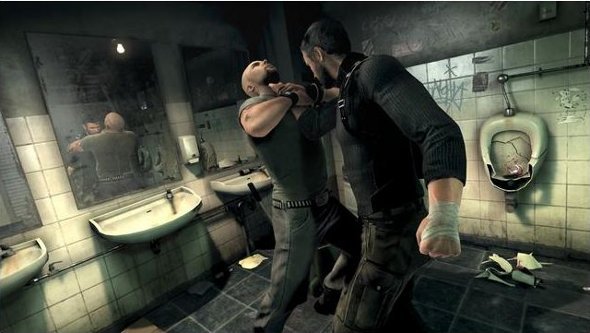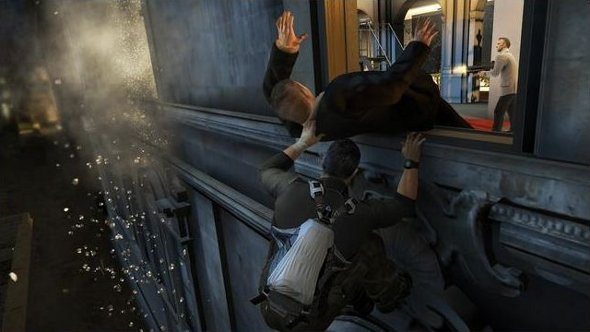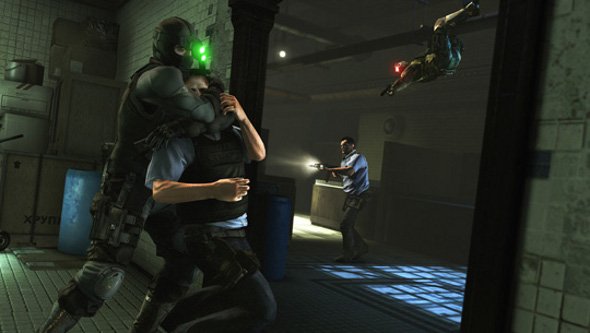
Gamers generally like to shoot things more than sneak around them. Ubisoft has spent the last four years trying to make Splinter Cell: Conviction, the latest installment of their stealth series, palatable to action fans. The result is one of the most user-friendly stealth games in memory. However, the hefty demands of the stealth and action genres lead to some awkward compromises in Conviction's design.
The plot of Conviction's single-player is well-suited for the transition to action. Sam Fisher, formerly an operative with secret agency Third Echelon, has gone rogue. He learns that his daughter's death wasn't a simple hit and run. It's connected in some way to a wider conspiracy that threatens the United States. Just like old times, Fisher has to stop a terrorist plot. However, he's no longer restrained by laws or regulations. Were this a 1980's cop film, the poster would read: "This time, it's PERSONAL."
With no agency to supply him with information, Fisher now has to beat his intel out of enemies. Throughout the plot he'll use "enhanced interrogation techniques" on key characters to learn more about the conspiracy he's investigating. The manner in which he beats up these poor saps is up to the player. Fisher will use whatever object he's next to in order to inflict pain. If you drag the target next to a mirror, he'll slam the guy's face through it. The target will then offer up a bit of information before becoming reluctant to divulge any more. The cycle repeats until Fisher finally kills the dude.
The interrogations are a good story-telling mechanic but never really feel like a game. It's more engaging than a cutscene and roughing up a terrorist has its own simple appeal. However, all the player is really doing here is walking over to objects in the room and pressing a single button. There's no challenge there. Your presence is all that's required to keep the scene going.
Unlike previous games, Fisher isn't as concerned with limiting casualties or avoiding detection. There's only maybe two sequences where you're not allowed to be spotted by enemies. Therefore you can be as sloppy and violent as you want, as long as you can survive the onslaught of guards. Sam's health regenerates but he can't take as many hits as his enemies, some of whom are wearing full body armor. Furthermore, only a handful of guns can be upgraded with scopes (you can zoom in only slightly with unscoped weapons) so long-distance sniping isn't a viable option. While it can look and feel at times like a third-person shooter, you're not rewarded for playing it like one.

Instead, you're better off killing enemies silently. Manually headshots with silenced weapons work but the best way to clear a room is with the new Mark and Execute feature. After performing a hand-to-hand kill, Fisher earns an execute, the ability to instantly kill multiple foes at once. The max number you can kill varies from two to four, depending on what weapon you're using. You tag the enemies with the right shoulder button and an arrow icon appears above their head. When they're within range of an execute, that arrow becomes red. Press Y and Fisher will cap the marked enemies with a series of headshots in slow motion. It allows you to kill a group of foes without one of them raising the alarm.
While you can mark and execute enemies even after they've seen you, planning your attack in advance works best. You can mark enemies if you don't have an execute, or if you only see them through use of gadgets. Let's say you're outside of a room with four guys in it and you're lacking an execute. You can mark up the three that are further away with your snake cam, then run into the room and hand-to-hand kill the closest. As his friends start to react, you unleash the execute you just earned.
Your Daily Blend of Entertainment News
The game displays ample visual cues to allow the player to understand the stealth system. When you're safely in the shadows, the game's graphics go from color to black and white with occasional highlights (enemies are in full color, for example). The game employs a cover system and when you want to sneak to another piece of cover, the game will indicate exactly where you'll slide to with an arrow based on where you're aiming. When you're visible to an enemy, a white circle will appear on screen with an arrow indicating the direction of the person who spot you. If you stay in sight, this arrow narrows (quickly or slowly, depending on how visible you are) until the circle turns red and you're detected. After being detected, a ghost image of Sam appears in the spot where you were found. This indicates where enemies think you are and helps you formulate flanking strategies. These little graphical touches probably help the learning process for newbies but even stealth game vets have to agree that these are helpful aids.
What's weird about Conviction's stealth, though, is that you can no longer hide dead bodies. You can take an enemy hostage and drag him to a more secluded location but this workaround is unnecessary save for the two situations where you're not allowed to be detected. To compensate for the lack of corpse hiding, Ubisoft made guards' reaction to dead bodies very muted. They'll something to the effect of, "Oh crap!" and begin to sweep the area but they're not as freaked out as you would've expected. Were I a faceless henchman who found my comrade dead in the middle of our base, I'd probably raise some sort of alarm and try to round up as many of my friends as possible to find the intruder. It takes a lot of prodding to get the guards that riled up, though.
While I wouldn't say they're smart, the enemies at least show a bit of thought. In an extended battle they start to lose their shit, kind of like their counterparts in Batman: Arkham Asylum. They fire at your ghost image's location, taunt you to come out, and sweep their flashlight-mounted guns around erratically to try and spot you. While they'll often move to intercept you, sometimes they'll hang back and wait for you to attack. It's tough to get excited over the A.I. for a foe that's standing still but it's preferable to having enemies march into your traps single file like Lemmings. There's enough intelligence in these henchmen to keep you from using one trick over and over.

The gadgets you'll use are pretty close to the selection from previous Splinter Cell installments. Sam's no longer a Third Echelon agent but he manages to get his hands on most of his old favorites like EMP grenades and sticky cameras. The primary difference is that, because no one's telling you not to kill people, there's no need for you to have non-lethal takedown items like tranquilizer darts. While the developers toy with the idea of Sam being a more "low tech" spy - in the first mission, he uses a mirror he yanked from a car to look under doors - they never commit to that vision.
The sonar goggles, replacing the infrared/night vision goggles from previous games, are bound to be a controversial addition. The goggle send out pulse of sounds that detect nearby structures and, more importantly, enemies. While this sounds like an "I Win" button, it's not as unbalanced as you'd expect. The information being sent through the goggles becomes distorted if you move quickly and you're unable to see whether you're in the shadows or not. Furthermore, you're not the only one with these goggles. In a few spots you'll fight enemies who also have them, resulting in very tense encounters where you're forced to keep moving in order to avoid being hunted down.
Conviction's single-player campaign, about five to six hours, isn't as good as the gameplay mechanics would dictate. Though the game's premise would indicate a more personal or emotional storyline about Sam, the plot quickly turns toward boilerplate spy novel gibberish about mercenaries, weapons of mass destruction, government agencies, and the like. The game takes very awkward turns to accomodate this story. In order to introduce us to a new character, we're forced to plod through a third-person shooter-style flashback level in Iraq that's bereft of all stealth and the mark/execute system. To listen in on the bad guy's plot, there's a level where you hack into a security camera and watch two characters having a conversation. Seriously, that's the level - you point a camera at them and watch them talk. In order to explain the last pieces of the plot, Ubisoft decides to make the final scene of the game a face-to-face conversation between Fisher and the main villain. It's a pseudo-cutscene and a poor way to cap off the game.
Fortunately, Conviction is a lot more than just Fisher's story. The game has a full suite of two-player multiplayer modes. The most prominent is a prequel co-op campaign that's comparable in length to the single-player outing. Archer and Kestrel, an American and Russian agent, team up to track down three warheads being sold on the black market. This, and the other multiplayer modes can be played online or locally through system link or split-screen. The Achievement-like challenges you complete in any mode (such as "Kill three or more enemies with a frag grenade") earn you points for unlocking weapons and upgrades for use across all modes.
While the co-op story's no more coherent than that of the single-player, the co-op campaign doesn't allow itself to be driven off a cliff by plot demands. It sticks to the core Splinter Cell experience: sneaking around and killing lots of people in the process. The same can be said of the Hunter and Last Stand game modes, which feature the maps from co-op as well as a couple new ones. In Hunter, your objective is to kill all of the guards in a series of zones within the map. If the guards raise the alarm, ten more of their comrades will flood into that zone. Last Stand, meanwhile, has you and a friend defending an EMP device from waves of enemies.

Playing with another person adds another layer to the gameplay. Stalking hapless guards is more fun with a partner, too. You can pull off dual executes, in which you join together to shoot down marked targets. Executing from two different vantage points means you no longer have to wait for guards to become closely grouped to kill them in one fell swoop. The mission ends if your partner dies so you have to watch each other's backs. Even if one of you is about to die, though, there's still cooperation at work. If you get wounded, you can sit up and take potshots at enemies while waiting for your partner to revive you. When an enemy gets you in a chokehold, you can elbow him to give you partner a clear shot at him.
Though you can play online, I'd highly recommend local multiplayer. While playing over Xbox Live I experienced many disconnects. When this happens while playing the co-op campaign, you'll lose all of your progress on the current mission. You can also play Hunter and Last Stand maps by yourself but unfortunately no such option exists for the campaign. Designing a bot that could effectively play this game alongside you must be a daunting and/or time-consuming task.
There's another reason why I'd suggest local multiplayer besides connection issues, though. The fact is, playing with a friend is going to go a lot smoother than playing with some random guy through matchmaking. Co-op stealth requires a bit more coordination and patience than you'd need in, say, Gears of War 2. In the first segment of the second co-op campaign mission, you fail if you're spotted by the guards. Imagine doing that with a newbie, much less one without a headset.
Conviction's lack of team-based competitive multiplayer is what will likely frustrate fans the most. The only competitive mode in the game is Face-Off, a 1v1 match where two players try to rack up higher scores by killing waves of enemies and each other. It's hard not to view this as a step backward from Splinter Cell: Double Agent's Spies vs. Mercenaries multiplayer, in which one team tried to infiltrate a base and retrieve encrypted files while the other team tried to stop them. Conviction's inability to offer up something similiar, if not better, is a blow to the game's replayability.
Neither long-time Splinter Cell fans nor hardcore shooter devotees will be completely pleased with Conviction. The former group will be frustrated by what's been cut from previous games while the latter will realize that, though Conviction looks a lot like a shooter, it's a stealth-action game at its heart. Still, if you belong to either group and enjoy co-op, this game has a lot to offer you.
Players: 1-2
Platform(s): Xbox 360 (reviewed), PC
Developer: Ubisoft Montreal
Publisher: Ubisoft
ESRB: Mature
Rating:

Staff Writer at CinemaBlend.

